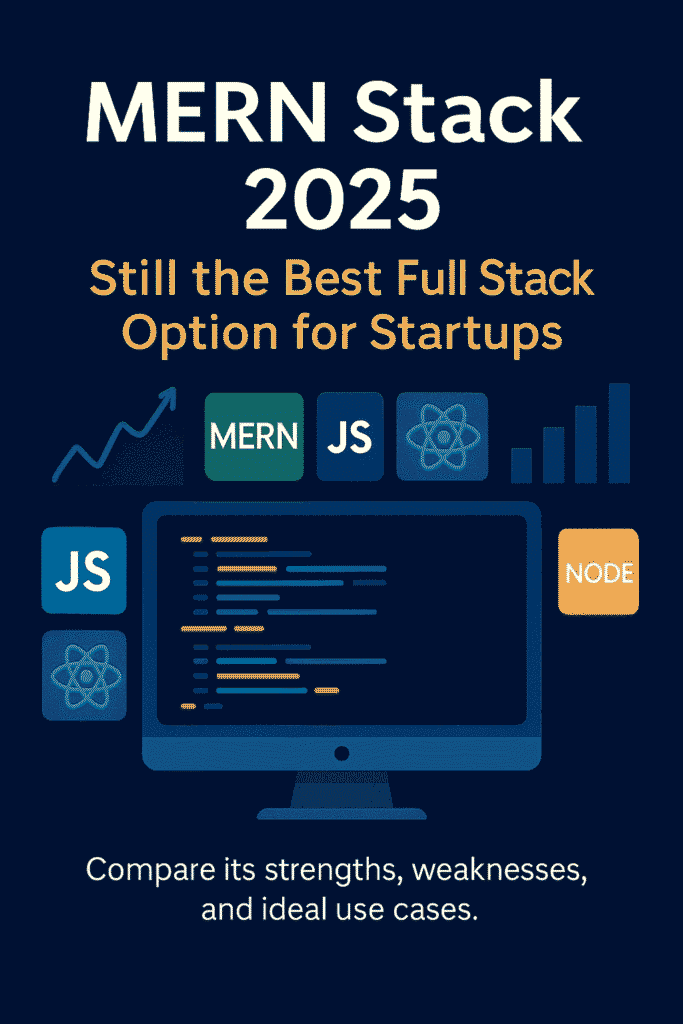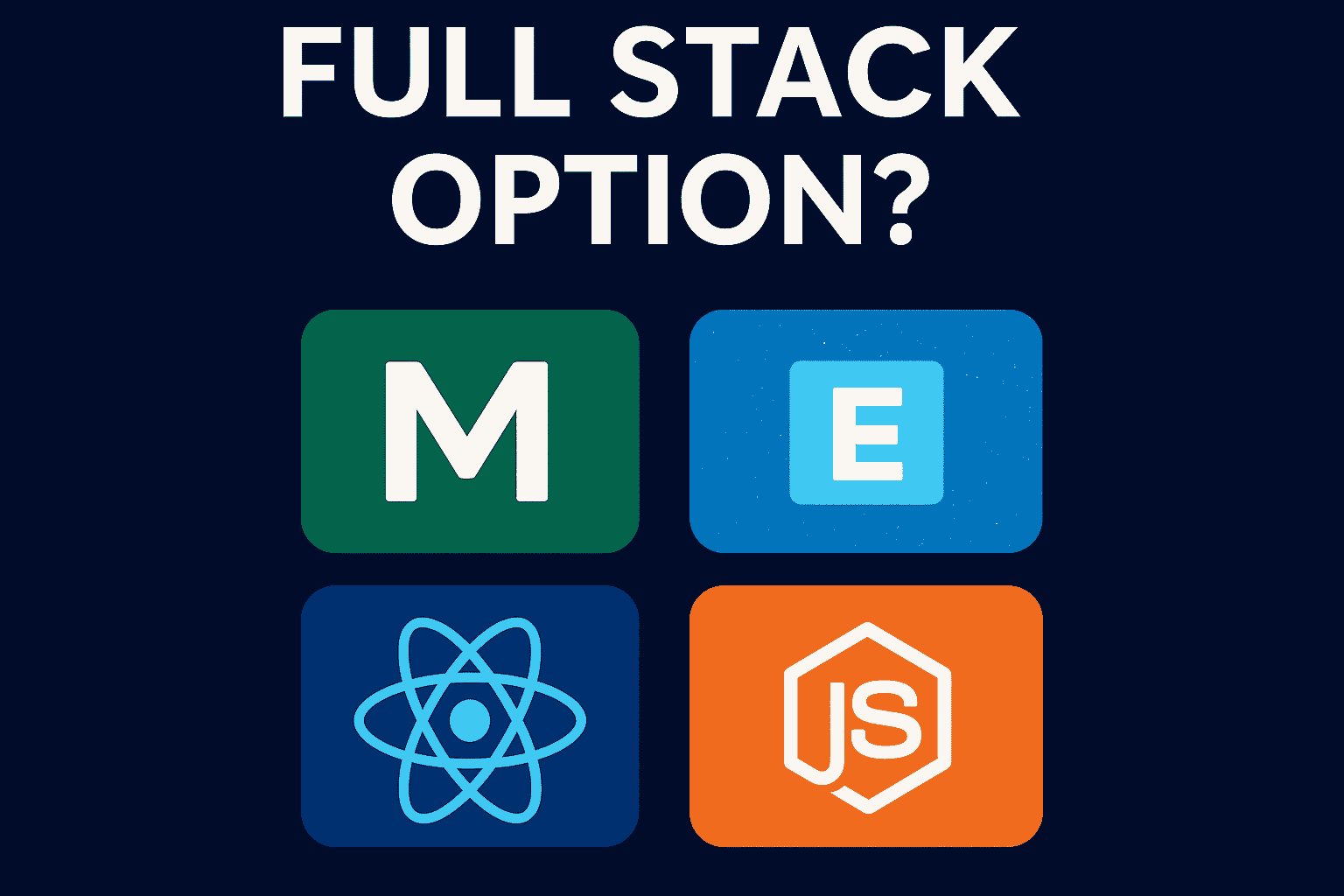MERN Stack in 2025: Is It Still the Best Full-Stack Option?

Introduction
MERN Stack 2025 continues to dominate full-stack development discussions. In 2025, startups and tech teams are still asking: Is the MERN Stack the best full-stack solution?
This blog breaks down MERN’s strengths, its evolution, how it compares to other popular stacks, and when you should or shouldn’t use it.
What Is MERN Stack?
The MERN Stack is a JavaScript-based technology suite that includes:
With its flexibility and active ecosystem, MERN Stack 2025 is especially suited for fast-moving startups and real-time use cases.
- MongoDB – NoSQL document database
- Express.js – Lightweight backend web framework
- React.js – Frontend library for building UIs
- Node.js – JavaScript runtime for server-side logic
It allows full-stack development using a single language (JavaScript) across client and server — which means faster development cycles and more cohesive teams.
Why MERN Stack Is Still Relevant in 2025
✅ Unified Language
- Full JS stack = faster onboarding, smaller dev teams, reusable code.
✅ Massive Ecosystem
- MERN benefits from npm, VSCode, GitHub Copilot, TypeScript, Vite, and React Server Components.
✅ Real-Time Ready
- With WebSockets and Node.js, real-time apps like chats and live dashboards are easy to build.
✅ Enterprise Adoption
- Still used by startups and enterprises for internal tools, portals, and SaaS platforms.
✅ Compatible With AI/ML Integrations
- Node.js backends work seamlessly with AI APIs like OpenAI, making it a great choice for 2025 AI-native apps.
🌐 MERN vs Other Stacks in 2025
| Feature | MERN Stack | MEVN Stack | MEAN Stack | Jamstack |
|---|---|---|---|---|
| Language | JS/JSX | JS/Vue | JS/Angular | Static + APIs |
| Learning Curve | Moderate | Beginner-Friendly | Steep | Beginner |
| Performance | High | High | Medium | Fast (Static) |
| SSR Support | Yes (Next.js) | Yes (Nuxt.js) | Basic | Yes |
| Real-time | Excellent | Great | Limited | Poor |
| Flexibility | High | Medium | Medium | Low |
| AI Integration | Easy | Easy | Complex | Depends |
Verdict: MERN still offers the best balance of flexibility, scalability, and speed for startups needing real-time, dynamic apps.
When Not to Use MERN
- You need ultra-fast static sites (Jamstack is better)
- You have strict SEO requirements (Next.js is preferred over pure MERN)
- Your team is more experienced in Vue or Angular
- You want plug-and-play CMS (Jamstack or WordPress)
💡 Popular Projects Built with MERN Stack 2025
Many new-age SaaS startups, eCommerce platforms, and AI tools in 2025 continue to rely on the MERN Stack. Projects like internal dashboards, real-time messaging apps, Best AI-integrated CRMs, and customer portals are thriving on this stack. The stack’s modular nature allows teams to scale from MVPs to enterprise-level apps seamlessly.
Tools Enhancing MERN in 2025
- Next.js – For SSR + React
- Tailwind CSS – For Best & rapid styling
- PlanetScale – Scalable database alternative to MongoDB
- Prisma – ORM for MongoDB
- Render / Vercel / DigitalOcean – Cloud hosting for MERN apps
🧰 Internal Links
⚠️ External Links
FAQs – MERN Stack in 2025
Q1: Is MERN still beginner-friendly in 2025? Yes. With tools like Vite, React DevTools, and better tutorials, it’s easier than ever to start.
Q2: Is MERN good for AI or ML apps? Absolutely yes. Node.js integrates well with AI APIs, and you can serve ML models from Python backends using microservices.
Q3: Can MERN handle high-traffic apps? Yes, if architected properly with load balancers, caching (Redis), and async handling.
Q4: Will MERN be replaced soon? No. It’s evolving, not dying. Modern tools like Next.js and tRPC extend its life.
Final Thoughts
MERN Stack remains a powerful and future-proof solution for 2025. While alternatives like Jamstack and MEVN are great for specific cases, MERN’s unified language, community support, and flexibility make it the go-to for building scalable, real-time applications.
At LogicNosh, we specialize in custom MERN applications optimized for your growth.
👉 Want to build something great? Let’s talk today.








Getting it broadcast someone his, like a missus would should
So, how does Tencent’s AI benchmark work? Prime, an AI is foreordained a shrewd subjugate from a catalogue of via 1,800 challenges, from edifice materials visualisations and царствование беспредельных потенциалов apps to making interactive mini-games.
In this age the AI generates the rules, ArtifactsBench gets to work. It automatically builds and runs the regulations in a okay as the bank of england and sandboxed environment.
To prophesy how the labour behaves, it captures a series of screenshots upwards time. This allows it to charges against things like animations, sector changes after a button click, and other spry consumer feedback.
In the last, it hands atop of all this evince – the starting importune, the AI’s encrypt, and the screenshots – to a Multimodal LLM (MLLM), to law as a judge.
This MLLM find isn’t orthodox giving a inexplicit философема and as contrasted with uses a lesser, per-task checklist to iota the d‚nouement come yon across ten diversified metrics. Scoring includes functionality, purchaser semblance, and the unaltered aesthetic quality. This ensures the scoring is light-complexioned, in harmony, and thorough.
The conceitedly concern is, does this automated reviewer justifiably comprise hawk-eyed taste? The results supporter it does.
When the rankings from ArtifactsBench were compared to WebDev Arena, the gold-standard principles where legitimate humans ballot on the most befitting AI creations, they matched up with a 94.4% consistency. This is a brobdingnagian aid from older automated benchmarks, which come around c regard what may managed in all directions from 69.4% consistency.
On lid of this, the framework’s judgments showed in saturation of 90% rationale with okay fallible developers.